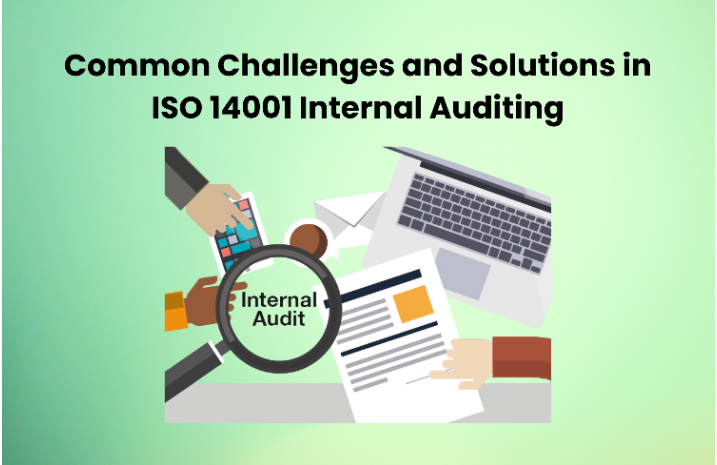Obtaining and keeping ISO 14001 Certification is a substantial environmental management accomplishment for businesses dedicated to sustainability. The ISO 14001 standard helps set up, implement, maintain, and improve an environmental management system (EMS) over the years. However, achieving certification requires more than initial compliance; proactive and watchful behaviour is necessary, specially concerning internal auditing.
In this blog, we will look at common issues during an ISO 14001 Internal Audit and offer guidance on making the certification method smooth and a success.
Table of Contents
- The Significance of ISO 14001 Certification
- What is ISO 14001 Internal Audit?
- Challenge 1: Handling Complex Regulatory Changes
- Challenge 2: Ensuring Employee Engagement and Awareness
- Challenge 3: Balancing Resources and Objectives
- Getting Around the ISO 14001 Certification
- Challenge 4: Handling Data Accuracy and Management
- Challenge 5: Handling Opposition to Change
- Conclusion
The Significance of ISO 14001 Certification
Let’s first recognise the significance of ISO 14001 certification before addressing common troubles and solutions associated with ISO 14001 internal audits. This widely accepted standard tries to assist companies in tackling environmental issues in an organised manner, showcasing their dedication to sustainable operations. An enterprise’s dedication to minimising its environmental effects and promoting a culture of steady improvement is indicated by means of its ISO 14001 accreditation.
What is ISO 14001 Internal Audit?
Internal audits guarantee that an organisation’s EMS is properly implemented and complies with ISO 14001. They efficiently determine areas needing development, assess compliance, and foster an eco-aware culture. However, like every essential system, ISO 14001 internal auditing has its share of difficulties.
Challenge 1: Handling Complex Regulatory Changes
One of the main challenges in ISO 14001 internal audits is keeping up with the changing environmental necessities. Organisations need help maintaining EMS compliance on the grounds that legal guidelines and policies constantly change.
Solution
To cope with this difficulty, corporations need to set up a dependable mechanism for tracking regulatory modifications. Internal auditors must attend regular training sessions to stay updated on latest advancements. Our proactive strategy guarantees that audits remain efficient and compliant despite constantly evolving laws.
Challenge 2: Ensuring Employee Engagement and Awareness
Another frequent challenge is growing personnel involvement and awareness of environmental management. An EMS may not function as effectively without a knowledgeable crew.
Solution
Extensive training programs and communication strategies have to be carried out to triumph over this impediment. Workers need to understand the value of ISO 14001 certification and how their activities have an effect on the EMS’s ordinary effectiveness. Regular communication channels like newsletters and training sessions can preserve a high degree of awareness and participation.
Challenge 3: Balancing Resources and Objectives
Many corporations stumble upon the problem of allocating enough resources for internal auditing while juggling other operational goals. Time restraints, economic barriers, and conflicting goals may impede internal audit effectiveness.
Solution
Allocating resources strategically is critical to overcoming this impediment. Companies ought to cautiously examine the assets they require for internal auditing, assign those assets, and rank their goals in line with importance and risk. With this approach, internal audits are assured to stay at the front of the mind without jeopardising corporate operations.
Getting Around the ISO 14001 Certification
Resolving troubles with ISO 14001 internal auditing requires perseverance, strategic thinking, and an ongoing development mentality. Businesses can obtain and maintain their ISO 14001 accreditation by way of tackling those troubles head-on.
Challenge 4: Handling Data Accuracy and Management
Maintaining accurate and reliable records is essential for ISO 14001 internal audits. Reviews may be erroneous due to missing or faulty statistics, making it more challenging to identify areas for improvement.
Solution
Automated data management systems are a workable way to deal with this problem. These systems enhance the integrity and correctness of environmental performance records. Automation expedites the audit process and lowers the chances of human error, freeing auditors to concentrate on evaluation and pointers for development.
Challenge 5: Handling Opposition to Change
Resistance to change is a common problem in all organisational strategies, which includes internal auditing. Implementing ISO 14001 criteria might also stumble upon resistance from staff members who are resistant against new procedures or adjustments to existing workflows.
Solution
Using efficient change management strategies is critical to getting over resistance. To make certain of a smooth transition, organisations must make sure that staff understand the advantages of ISO 14001 certification, involve them inside the procedure, and provide help and training. Businesses can correctly manage this trouble by cultivating a culture that welcomes change.
Conclusion
Ultimately, attaining and sustaining ISO 14001 certification requires a proactive and organised approach to addressing the obstacles associated with internal audits. Organisations that want to address issues with worker involvement, data accuracy, and legislative changes must regularly update their environmental management systems. Businesses can establish a sustainable and environmentally conscious culture at the same time as ensuring the long-term fulfilment of their EMS by means of utilising automated data management systems and adopting change management tactics. For more information visit: The Knowledge Academy.
Read more informative blogs here.




